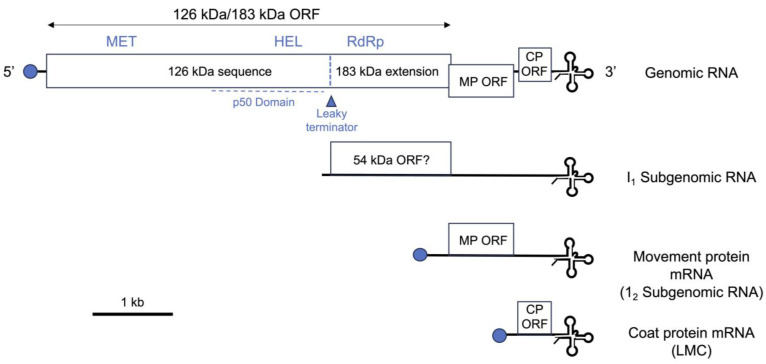Figure 1.
A diagram showing the organization of a representative tobamovirus (tobacco mosaic virus strain U1) genome indicating the viral genes and gene products mentioned in the text. Horizontal lines represent RNA and boxes represent open reading frames (ORFs) for known or putative viral proteins. The full length 183 kDa replicase protein is synthesized by read-through of a leaky termination codon at the end of the ORF encoding the 126 kDa protein, indicated with a triangle. The 126 kDa protein is a replicase component with methyltransferase (MT) and RNA helicase (HEL) domains, as well as an RNA silencing suppressor. The HEL domain lies within the ‘p50’ domain, which is the elicitor for the N gene-mediated hypersensitive response (refer to Figure 2). Both the 126 and 183 kDa proteins are synthesized by translation of the genomic RNA. The readthrough region of the 183 kDa protein contains the viral RNA-dependent RNA polymerase (RdRp) active site. The movement protein (MP) and coat protein (CP) gene sequences are synthesized by translation of subgenomic mRNAs, which are generated during infection. An additional subgenomic RNA (‘intermediate 1’: I1) encoding a putative 54 kDa protein is produced during infection. The putative 54 kDa protein would have the same sequence as the readthrough region of the 183 kDa protein, including its RdRp domain. The I1 RNA is translatable in vitro but it is not known if it has mRNA activity in planta. The subgenomic RNAs and the genomic RNA share identical 3′-teminal tRNA-like structures. The 5′ termini of the genomic, MP and CP mRNAs are capped (blue circles), and this may also be true for the I1 RNA. Not shown is a short ORF for a 4 kDa protein overlying the MP and CP ORFs, which is present in some tobamoviruses, and which is thought to be translated by means of a putative internal ribosome entry site.

